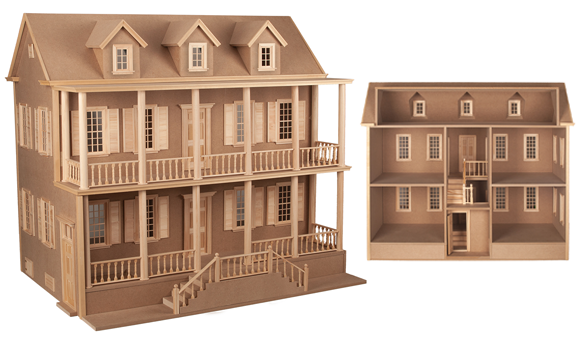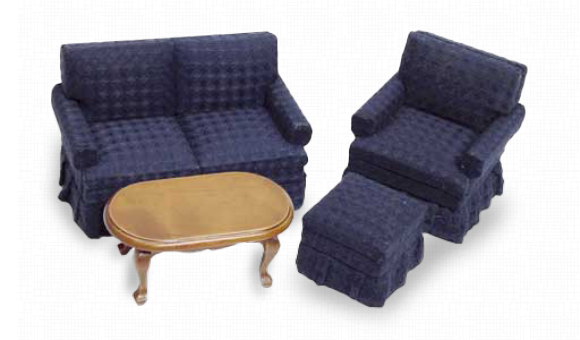by Fran Casselman

Materials:
#6016 Palladian Door (door slab)
#1123 Window Pull
Foam core (or other wall material)
Size #1 (8mm) sew-on snaps (a sewing notion, available at crafts stores and fabric stores)
Sequin pins or flat head pins (jewelry findings)
Packaging plastic (such as from a Houseworks door or window)
Strip wood, 1/4" x 1/16"
Cardboard, such as from a cereal box, legal pad or similar, 1/32" thick
One plastic-coated paperclip
Flush-cutting wire cutters
Super glue gel
Masking tape and basic craft tools/supplies
Instructions:
The wall may be made of any suitable material, but foam core was used here because it is lightweight and easy to cut while still being rigid enough in this small size. The directions that follow may have to be adapted if another material is used. It is also assumed that the wall is not installed and can be worked on while flat.
In this project, the wall is made of 3/16" foam core board. The door opening is centered, because the split door used here requires wall space on each side to open fully. If you use a single door in a wall this size, the opening should be to one side so the door can open all the way. The wall may be any size that is at least twice the width of the door, and will look better if it is an inch or so wider.
This project can be made with any style of ready-made door or you can make a door to suit your scene. This type of door has no frame so a ready-made door will have to be removed from the frame. On all Houseworks doors, there is a small nail or pin at the bottom of the frame where the door hinges. Remove this pin and you can angle the door out of the frame. There is a top pin also; if it remains in the door when you take it out of the frame, remove it so that you have only the wooden slab with no hardware.
Make the wall the size you will need and plan (but do not cut) the location of the opening. The opening should be slightly smaller than the door. Place the door in position, flush at the floor, and mark the top of the door on the wall. Then, mark a line across the wall 1/16" to 1/8" above the door height. This is where the door will actually hang, so that it does not scrape or bind on the floor. (Note: if the wall will go in before any finished flooring, allow for the thickness of the flooring.)
Paint or stain the door as desired. If your door has glazing, decide whether you want it to keep the transparency of the original door or be more obscured. You have many options*, but the glazing in the doors used here was replaced with two layers of #0029 Rippled Water Sheet. You may add any knobs or handles now, or later.
*Other options to replace glazing in a door include mirror sheet, thin wood panel (if the door is stained) or cardboard (if the door is painted). The original acrylic glazing can be roughened with fine sandpaper (on both sides) for a frosted-glass appearance. Grillework appliques may be used on top of or instead of a filler panel.
In an actual sliding door system, an iron rail is hung above the door opening and held slightly away from the wall to allow a pair of flanged wheels to roll along it. The door is suspended from the wheels by iron straps; the wheels are held on the rail by gravity.
The miniature door’s rail needs more support so it has a strip wood foundation with a thin, narrow cardboard spacer strip. The rail and straps are strips of packaging plastic, and the wheels are sew-on snaps. Each door panel requires two strap/wheel assemblies.
 Prepare the straps
Prepare the straps
Cut a strip of packaging plastic** about 1/8" wide and long enough for the two (or four) assemblies you will need. The length is whatever looks right to you, but it must be long enough for two fastening points (“bolts”) on the door and about 5/16" extension above the door. Trim the ends in a pleasing shape but do not change the length. About 1/8" from the top end of the strap, use a pushpin or T-pin to pierce a hole through the strap. Make another hole about 5/16" below the first one, and a third about 3/16" below that. Make holes in both (all) straps. Hole placement must be identical for all straps.
**A thicker material, such as 1mm styrene sheet (from hobby stores and art suppliers) may be used and will actually work a little better, but it will have to be drilled to accept the pins. Do not use wood; it will split. Some miniaturists use thin aluminum from tealight candle cups, but for this use it may bend and the doors will not hang straight.
Prepare the wheels
You need both pieces of a snap to make a wheel. Open the snaps to remove them from the packaging and snap them together again. When viewed from the edge, you will see a thicker side and a thinner side. The thicker side is the front and the thinner side is the back. Find a plastic-coated paperclip (any color, standard #1 size, not jumbo) and bend the outside straight section away for easier access. With a knife or scissors, cut through just the plastic coating and slide it off of the wire (a half-inch length is plenty). Cut this into pieces, about 1/16" long, one for each wheel. Put a sequin pin or head pin through the top hole in a strap and through the front center hole of a snap. Slip a length of the tiny tube over the tip of the pin. Hold the snap tightly to the strap and pin, and put a tiny amount of super glue gel near the snap. Slide the tube through the glue and into the recess of the snap. Hold the pieces together while the glue sets, but rotate the snap on the pin to be sure it has not stuck to the glue. Repeat for the other strap(s) and set aside to allow the glue to cure thoroughly, at least overnight. Glue strength increases greatly when left undisturbed.
 Prepare the support bar
Prepare the support bar
Cut a piece of 1/4" x 1/16" strip wood to length (a bit more than twice the width of the door) for the support bar. Find or laminate layers of cardboard to 1/32" thickness. Cut a piece 1/8" wide x the length of the bar. Cut two pieces of packaging plastic, 5/16" wide and 1/8" wide, x the length of the bar. Use white glue to glue the cardboard piece to the wood piece, flush along one long edge (now the bottom). Sand the plastic pieces lightly to roughen the surface for better adhesion. Use very small amounts of gel super glue (CA), or super glue and white glue together, to glue the wider piece to the cardboard, flush at the bottom and creating a channel where the wheels will rest. Be sure there is no excess glue in the channel. Glue the narrow plastic strip under the bottom to add strength and create a smooth appearance. Set this assembly aside to dry thoroughly, at least overnight. The bonds must be very strong.
When the glued straps and bar are thoroughly set, paint the areas that will show. Keep paint out of the channel as much as possible.
Assemble the sliding door unit
Check that the wheels rotate and are well attached to the straps. With flush-cut wire cutters, cut the pins at the back of the wheels, as close as possible. Fit a wheel onto the bar (only the back section goes into the channel) and determine how much gap to leave between the top of the door and the bottom of the bar. If you leave about 3/16" gap, you should be able to hang or remove the doors after the wall is in place. If you leave less gap on a narrow wall (as here), the doors will have to be installed with the wall, because there would not be enough room to slide them on/off the end of the bar. Measure the gap amount and mark a line on the wall, above the earlier line for the top of the door. Tape the bar to that line, tape the door to the first line and, with the wheel still in the channel, position the strap on the door near one side. Use a pin to mark the door through the holes in the straps. Mark the other strap position(s). Remove the wheel from the channel and attach the straps/wheels to the door(s) with sequin pins or head pins, drilling as necessary. The pins will extend through the door. Once they are in place and all the way against the door, mark the extending ends, pull the pins out one at a time and cut slightly shorter with the flush cutter. Put a tiny amount of super glue gel on the shaft of the pins and push them back into place. Paint the pin heads. Hang the doors on the bar to confirm there is the right amount of gap and adjust as needed.
Use measurements or a paper template to record the line positions on your wall. Cut the door opening and finish the wall as desired. Re-mark the line for the bar and glue it in place. Let it dry and hang the doors. If your wall is wide and a door could slide off the end of the bar, glue a tiny block inside the channel as a stop. Install the wall in your structure.



